A Novel Deep Learning Approach for Real-Time Critical Assessment in Smart Urban Infrastructure Systems
Abstract
1. Introduction
How would a deep-learning-based approach further improve the prediction and assessment of criticality in urban infrastructure systems if it acquires and integrates spatial information, as well as dependencies over time?
- Development of a novel architecture that integrates CNNs and LSTMs to simultaneously capture spatial and temporal dependencies in urban infrastructure data.
- Implementation of advanced techniques to preprocess, normalize, and integrate diverse data sources, including environmental, demographic, and infrastructural data.
- Establishment of a robust evaluation framework employing multiple performance metrics, such as MAE, RMSE, and R-Squared, to rigorously assess the model performance and provide dynamic, real-time criticality assessments.
2. Related Work
3. Proposed Methodology
3.1. Model Overview
3.1.1. Data Collection and Preparation
- Severity/Vulnerability Measures: These stand for measures that show the subsequent nature: Electricity Use Total, measured in million kWh; Level of Flooding; Population; Percent of Poverty; and Energy Consumption Total, measured in MMBtu. In general, these variables provide a view on the likelihoods of risks and vulnerabilities that would underline each geographical zone, focusing on parameters directly related to the energy use and conditions at times bordering with socioeconomics.
- Criticality Measures: This category takes into consideration the number of nodes and diversity for each zone. The variables allow for looking at the criticality of the infrastructure components based on the number of systems involved and the complexity or integration of the systems.
- Interdependence Measures: This section of the dataset captures Interdependence Total Value, Total Average Time to Cascade, and Outage Number per Year. These very critical measures help not only understand how the failure of one infrastructure component may cascade to another, pointing out the possibility for cascading failures, but also provide insight into the degree of connection between different elements.
- Centrality Measures: It finally contains centrality measures, specifically the total Degree No. for all nodes, the total Betweenness value for all nodes, and the total Closeness value for all nodes. These metrics help quantify the relative importance of each node or component in the overall infrastructure network as this type of analysis identifies which are the critical components involved in holding an entire system together.
3.1.2. Feature Engineering
- Normalization: We standardized all numerical features to zero mean and one standard deviation. This step was significant for placing the data into different scales in a homogeneous way, hence enhancing actual neural network learning.
- One-Hot Encoding: One-hot encoding transformed categorical variables into a format readable by the neural network. The method that will be used in the transformation of categorical data into its binary vector representation is what will allow the model to process these features effectively.
- Missing Value Imputation: In order not to lose any information, missing values were imputed by the median of their corresponding features. This is a measure with the least effect on changing the data distribution and, hence, will not add any bias like other arbitrary imputation methods might.
- Feature Creation: We derived new features to capture additional insights that could enhance the model’s performance. The newly created features include:
- –
- Population-to-Area Ratio (Pdensity): This was achieved by dividing the number of people by the area of each geographical zone. This provides an idea of what the population density is, which is an important factor when considering infrastructure resilience or resilience assessment, as it helps with allocating resources.
- –
- Energy Per Capita (Ecapita): This feature was computed using total energy consumption divided by population size. It helps with assessing how efficient it is in using energy relative to its population and how much energy it requires compared with its population.
3.2. Deep Learning Model Architecture
3.2.1. Convolutional Neural Network (CNN) Component
| Algorithm 1: Convolutional Neural Network (CNN) Component |
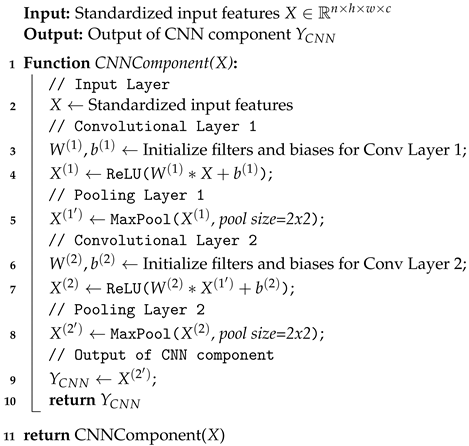 |
- Input Layer: Receives the standardized input features. The input to CNN can be represented as a tensor , where h and w are the height and width of the spatial dimensions, respectively; n is the number of samples; and c is the number of channels.
- Convolutional Layers: Multiple layers with filters to extract spatial features.
- –
- Conv Layer 1: This layer applies 32 filters of size 3 × 3 to the input data, with a ReLU activation function. The operation can be mathematically represented as follows:where are the filters, are the biases, X is the input, and * denotes the convolution operation.
- –
- Conv Layer 2: This layer applies 64 filters of size 3 × 3, again with a ReLU activation function. The operation can be represented as:where and are the filters and biases for the second convolutional layer, respectivey, and is the output from the first convolutional layer.
- Pooling Layers: Max pooling layers to reduce spatial dimensions while retaining the most significant features.
- –
- Pooling Layer 1: This layer applies max pooling with a pool size of 2 × 2, which can be represented as follows:where is the output of the first pooling layer and max is taken over the 2 × 2 regions.
- –
- Pooling Layer 2: This layer applies max pooling with a pool size of 2 × 2, similar to the first pooling layer:where is the output of the second pooling layer.
3.2.2. LSTM Network Component
- LSTM Layer 1: This layer contains 100 units, returns sequences, and so the output can be fed into the next LSTM layer. Equations that exactly describe the operation of an LSTM cell are as follows:In this context, denotes the forget gate, signifies the input gate, represents the candidate cell state, is the cell state, refers to the output gate, and is the hidden state. The functions and tanh are the sigmoid and hyperbolic tangent activation functions, respectively, each playing a vital role in the LSTM’s operation.
- LSTM Layer 2: This layer consists of 50 units and does not return sequences, providing a single output for each input sequence. The output from the first LSTM layer serves as the input to the second LSTM layer:where is the hidden state of the second LSTM layer, and is the hidden state from the first LSTM layer.
| Algorithm 2: Long Short-Term Memory (LSTM) Network Component. |
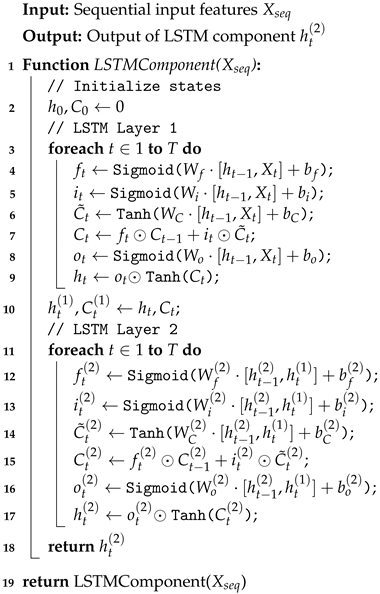 |
3.2.3. Fully Connected Neural Network Component
- Flatten Layer: This layer flattens the output from the CNN component into a one-dimensional vector:
- Concatenation Layer: This layer concatenates the flattened output from the CNN component with the output from the LSTM component:
- Dense Layers: Fully connected layers to perform the final prediction. These layers apply weights and biases to the input vectors, followed by ReLU activation functions:
- –
- Dense Layer 1: 128 neurons, ReLU activation:
- –
- Dense Layer 2: 64 neurons, ReLU activation:
- –
- Output Layer: 1 neuron with a linear activation function for regression:
4. Simulation and Results
- Hardware: The simulation were conducted on a device equippred with Intel Core i7 processor, 32 GB RAM, and an NVIDIA GTX 1080 Ti GPU.
- Software: The model was implemented using Python with the TensorFlow and Keras libraries. Data preprocessing and analysis were performed using Pandas and NumPy.
- Dataset: The dataset used for training and testing the model included multiple measures indicative of the criticality of geographic zones, as described in Section 3.
- Training Procedure: The dataset was split into 80% training, 20% testing, and 20% of the training data were used as a validation set. The model was trained for up to 100 epochs with early stopping.
4.1. Feature Importance Analysis
- ResilientInfra achieved an average importance score of 0.09 for TEU and 0.08 for FL.
- SmartMG reported scores of 0.10 for TEU and 0.09 for FL.
- HybridEnsemble had scores of 0.11 for TEU and 0.10 for FL.
- UrbanLive demonstrated scores of 0.08 for TEU and 0.07 for FL.
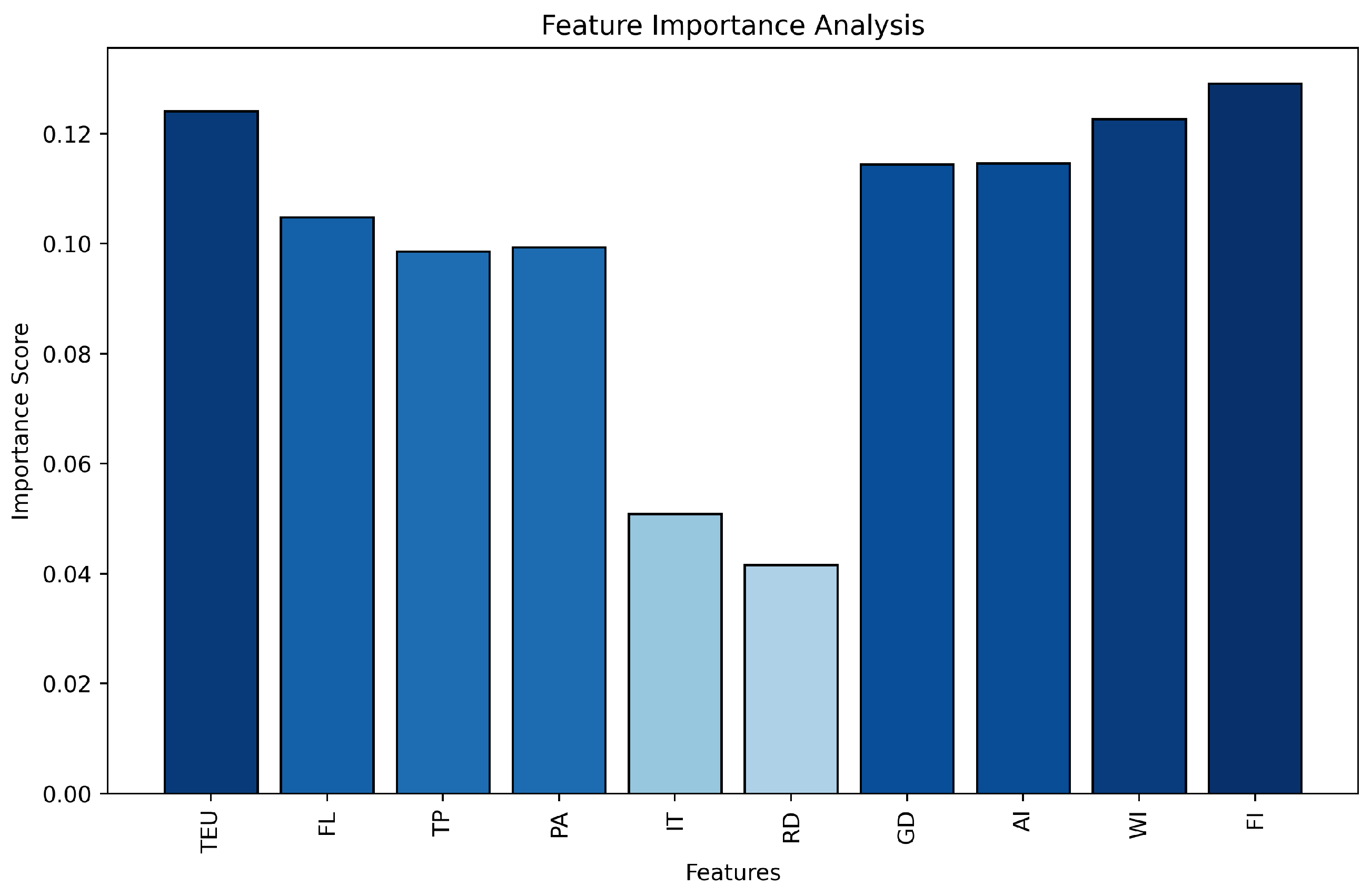
4.2. Learning Curve Analysis
- ResilientInfra [37]: Demonstrates a higher validation loss plateau at approximately 0.25, indicating less effective generalization compared with our approach.
- SmartMG [40]: Shows a validation loss plateau at around 0.22, which is higher than that of our model.
- HybridEnsemble [45]: Achieves a validation loss of approximately 0.20, slightly higher than our proposed approach.
- UrbanLive [49]: Exhibits a validation loss of around 0.21, also higher than the loss observed in our model.
4.3. Training vs. Testing Accuracy
- ResilientInfra [37]: Achieves a validation accuracy of 92% after 100 epochs, which is lower than our model’s 95%.
- SmartMG [40]: Reaches a validation accuracy of 93%, slightly lower than our model.
- HybridEnsemble [45]: Shows a validation accuracy of 94%, close to but still less than our proposed approach.
- UrbanLive [49]: Exhibits a validation accuracy of 93.5%, also lower than the accuracy achieved by our model.
4.4. Training vs. Testing Loss
- ResilientInfra [37]: Achieves a testing loss of 0.25, which is higher than our model’s 0.20.
- SmartMG [40]: Reaches a testing loss of 0.22, slightly higher than our model.
- HybridEnsemble [45]: Shows a testing loss of 0.21, close to but still higher than our proposed approach.
- UrbanLive [49]: Exhibits a testing loss of 0.23, also higher than the loss achieved by our model.
4.5. Prediction vs. Actual Values
4.6. Impact of Feature Selection
- Proposed Approach: Training MAE = 0.03, Validation MAE = 0.05
- ResilientInfra [37]: Training MAE = 0.04, Validation MAE = 0.06
- SmartMG [40]: Training MAE = 0.05, Validation MAE = 0.07
- HybridEnsemble [45]: Training MAE = 0.06, Validation MAE = 0.08
- UrbanLive [49]: Training MAE = 0.05, Validation MAE = 0.07
5. Discussion
6. Conclusions
Funding
Data Availability Statement
Conflicts of Interest
References
- Alsaleh, M.; Wang, X. How does information and communication technology affect geothermal energy sustainability? Sustainability 2023, 15, 1071. [Google Scholar] [CrossRef]
- Hashem, I.A.T.; Usmani, R.S.A.; Almutairi, M.S.; Ibrahim, A.O.; Zakari, A.; Alotaibi, F.; Alhashmi, S.M.; Chiroma, H. Urban computing for sustainable smart cities: Recent advances, taxonomy, and open research challenges. Sustainability 2023, 15, 3916. [Google Scholar] [CrossRef]
- Din, I.U.; Awan, K.A.; Almogren, A.; Rodrigues, J.J. Swarmtrust: A swarm optimization-based approach to enhance trustworthiness in smart homes. Phys. Commun. 2023, 58, 102064. [Google Scholar] [CrossRef]
- Awan, K.A.; Din, I.U.; Almogren, A.; Rodrigues, J.J. Artificial Intelligence and Quantum Synergies in Trust-Enhanced Consumer Applications for Software Defined Networks. IEEE Trans. Consum. Electron. 2024, 70, 791–799. [Google Scholar] [CrossRef]
- Hoang, M.L.; Matrella, G.; Ciampolini, P. Artificial Intelligence Implementation in Internet of Things Embedded System for Real-Time Person Presence in Bed Detection and Sleep Behaviour Monitor. Electronics 2024, 13, 2210. [Google Scholar] [CrossRef]
- Taherdoost, H. Security and internet of things: Benefits, challenges, and future perspectives. Electronics 2023, 12, 1901. [Google Scholar] [CrossRef]
- Awan, K.A.; Din, I.U.; Almogren, A.; Rodrigues, J.J. AutoTrust: A privacy-enhanced trust-based intrusion detection approach for internet of smart things. Future Gener. Comput. Syst. 2022, 137, 288–301. [Google Scholar] [CrossRef]
- Gracias, J.S.; Parnell, G.S.; Specking, E.; Pohl, E.A.; Buchanan, R. Smart Cities—A Structured Literature Review. Smart Cities 2023, 6, 1719–1743. [Google Scholar] [CrossRef]
- Zeng, F.; Pang, C.; Tang, H. Sensors on Internet of Things Systems for the Sustainable Development of Smart Cities: A Systematic Literature Review. Sensors 2024, 24, 2074. [Google Scholar] [CrossRef]
- George, A.; Ravindran, A.; Mendieta, M.; Tabkhi, H. Mez: An adaptive messaging system for latency-sensitive multi-camera machine vision at the iot edge. IEEE Access 2021, 9, 21457–21473. [Google Scholar] [CrossRef]
- Alahi, M.E.E.; Sukkuea, A.; Tina, F.W.; Nag, A.; Kurdthongmee, W.; Suwannarat, K.; Mukhopadhyay, S.C. Integration of IoT-enabled technologies and artificial intelligence (AI) for smart city scenario: Recent advancements and future trends. Sensors 2023, 23, 5206. [Google Scholar] [CrossRef]
- Monios, N.; Peladarinos, N.; Cheimaras, V.; Papageorgas, P.; Piromalis, D.D. A Thorough Review and Comparison of Commercial and Open-Source IoT Platforms for Smart City Applications. Electronics 2024, 13, 1465. [Google Scholar] [CrossRef]
- Taye, M.M. Understanding of machine learning with deep learning: Architectures, workflow, applications and future directions. Computers 2023, 12, 91. [Google Scholar] [CrossRef]
- Nsugbe, E.; Olorunlambe, K.; Dearn, K. On the Early and Affordable Diagnosis of Joint Pathologies Using Acoustic Emissions, Deep Learning Decompositions and Prediction Machines. Sensors 2023, 23, 4449. [Google Scholar] [CrossRef]
- Aljohani, A. Predictive analytics and machine learning for real-time supply chain risk mitigation and agility. Sustainability 2023, 15, 15088. [Google Scholar] [CrossRef]
- Awan, K.A.; Din, I.U.; Almogren, A.; Rodrigues, J.J. Privacy-Preserving Big Data Security for IoT With Federated Learning and Cryptography. IEEE Access 2023, 11, 120918–120934. [Google Scholar] [CrossRef]
- Ali, S.A.; Elsaid, S.A.; Ateya, A.A.; ElAffendi, M.; El-Latif, A.A.A. Enabling Technologies for Next-Generation Smart Cities: A Comprehensive Review and Research Directions. Future Internet 2023, 15, 398. [Google Scholar] [CrossRef]
- Cacciuttolo, C.; Garrido, F.; Painenao, D.; Sotil, A. Evaluation of the Use of Permeable Interlocking Concrete Pavement in Chile: Urban Infrastructure Solution for Adaptation and Mitigation against Climate Change. Water 2023, 15, 4219. [Google Scholar] [CrossRef]
- Miller, T.; Durlik, I.; Adrianna, K.; Kisiel, A.; Cembrowska-Lech, D.; Spychalski, I.; Tuński, T. Predictive Modeling of Urban Lake Water Quality Using Machine Learning: A 20-Year Study. Appl. Sci. 2023, 13, 11217. [Google Scholar] [CrossRef]
- Li, J.; Lin, S.; Kong, N.; Ke, Y.; Zeng, J.; Chen, J. Nonlinear and Synergistic Effects of Built Environment Indicators on Street Vitality: A Case Study of Humid and Hot Urban Cities. Sustainability 2024, 16, 1731. [Google Scholar] [CrossRef]
- Vahedi Nikbakht, M.; Gheibi, M.; Montazeri, H.; Yeganeh Khaksar, R.; Moezzi, R.; Vadiee, A. Identification and Ranking of Factors Affecting the Delay Risk of High-Rise Construction Projects Using AHP and VIKOR Methods. Infrastructures 2024, 9, 24. [Google Scholar] [CrossRef]
- Ren, W.; Wei, L.; Lu, X.; Xu, J.; Qin, Y. Spatio–Temporal Dynamic Characteristics and Driving Mechanisms of Urban Compactness in Central China. Urban Sci. 2024, 8, 40. [Google Scholar] [CrossRef]
- Khodadad, M.; Aguilar-Barajas, I.; Khan, A.Z. Green infrastructure for urban flood resilience: A review of recent literature on bibliometrics, methodologies, and typologies. Water 2023, 15, 523. [Google Scholar] [CrossRef]
- Asghari, F.; Piadeh, F.; Egyir, D.; Yousefi, H.; Rizzuto, J.P.; Campos, L.C.; Behzadian, K. Resilience Assessment in Urban Water Infrastructure: A Critical Review of Approaches, Strategies and Applications. Sustainability 2023, 15, 11151. [Google Scholar] [CrossRef]
- Samarakkody, A.; Amaratunga, D.; Haigh, R. Technological innovations for enhancing disaster resilience in smart cities: A comprehensive urban Scholar’s analysis. Sustainability 2023, 15, 12036. [Google Scholar] [CrossRef]
- Sani, S.; Xia, H.; Milisavljevic-Syed, J.; Salonitis, K. Supply Chain 4.0: A Machine Learning-Based Bayesian-Optimized LightGBM Model for Predicting Supply Chain Risk. Machines 2023, 11, 888. [Google Scholar] [CrossRef]
- Krishnan, S.; Aydin, N.Y.; Comes, T. TIMEWISE: Temporal Dynamics for Urban Resilience-theoretical insights and empirical reflections from Amsterdam and Mumbai. NPJ Urban Sustain. 2024, 4, 4. [Google Scholar] [CrossRef]
- Wang, M.; Lan, Y.; Li, H.; Jing, X.; Lu, S.; Deng, K. Spatial–Temporal Differentiation and Trend Prediction of Coupling Coordination Degree of Port Environmental Efficiency and Urban Economy: A Case Study of the Yangtze River Delta. Land 2024, 13, 374. [Google Scholar] [CrossRef]
- Lifshitz Sherzer, G.; Urlainis, A.; Moyal, S.; Shohet, I.M. Seismic Resilience in Critical Infrastructures: A Power Station Preparedness Case Study. Appl. Sci. 2024, 14, 3835. [Google Scholar] [CrossRef]
- Taye, M.M. Theoretical understanding of convolutional neural network: Concepts, architectures, applications, future directions. Computation 2023, 11, 52. [Google Scholar] [CrossRef]
- Liu, X.; Kounadi, O.; Zurita-Milla, R. Incorporating spatial autocorrelation in machine learning models using spatial lag and eigenvector spatial filtering features. ISPRS Int. J. Geo-Inf. 2022, 11, 242. [Google Scholar] [CrossRef]
- Graves, A.; Graves, A. Long short-term memory. In Supervised Sequence Labelling with Recurrent Neural Networks; Springer: Berlin/Heidelberg, Germany, 2012; pp. 37–45. [Google Scholar]
- Serrano, W. The blockchain random neural network for cybersecure IoT and 5G infrastructure in smart cities. J. Netw. Comput. Appl. 2021, 175, 102909. [Google Scholar] [CrossRef]
- Imteaj, A.; Khan, I.; Khazaei, J.; Amini, M.H. Fedresilience: A federated learning application to improve resilience of resource-constrained critical infrastructures. Electronics 2021, 10, 1917. [Google Scholar] [CrossRef]
- Almaleh, A.; Tipper, D. Risk-based criticality assessment for smart critical infrastructures. Infrastructures 2021, 7, 3. [Google Scholar] [CrossRef]
- Elvas, L.B.; Mataloto, B.M.; Martins, A.L.; Ferreira, J.C. Disaster management in smart cities. Smart Cities 2021, 4, 819–839. [Google Scholar] [CrossRef]
- Kumar, N.; Poonia, V.; Gupta, B.; Goyal, M.K. A novel framework for risk assessment and resilience of critical infrastructure towards climate change. Technol. Forecast. Soc. Chang. 2021, 165, 120532. [Google Scholar] [CrossRef]
- Mohammadpourfard, M.; Khalili, A.; Genc, I.; Konstantinou, C. Cyber-resilient smart cities: Detection of malicious attacks in smart grids. Sustain. Cities Soc. 2021, 75, 103116. [Google Scholar] [CrossRef]
- Otuoze, S.H.; Hunt, D.V.; Jefferson, I. Neural network approach to modelling transport system resilience for major cities: Case studies of lagos and kano (Nigeria). Sustainability 2021, 13, 1371. [Google Scholar] [CrossRef]
- Almaleh, A.; Tipper, D.; Al-Gahtani, S.F.; El-Sehiemy, R. A Novel Model for Enhancing the Resilience of Smart MicroGrids’ Critical Infrastructures with Multi-Criteria Decision Techniques. Appl. Sci. 2022, 12, 9756. [Google Scholar] [CrossRef]
- Wang, X.; Mazumder, R.K.; Salarieh, B.; Salman, A.M.; Shafieezadeh, A.; Li, Y. Machine learning for risk and resilience assessment in structural engineering: Progress and future trends. J. Struct. Eng. 2022, 148, 03122003. [Google Scholar] [CrossRef]
- Yuan, F.; Fan, C.; Farahmand, H.; Coleman, N.; Esmalian, A.; Lee, C.C.; Patrascu, F.I.; Zhang, C.; Dong, S.; Mostafavi, A. Smart flood resilience: Harnessing community-scale big data for predictive flood risk monitoring, rapid impact assessment, and situational awareness. Environ. Res. Infrastruct. Sustain. 2022, 2, 025006. [Google Scholar] [CrossRef]
- Sathurshan, M.; Saja, A.; Thamboo, J.; Haraguchi, M.; Navaratnam, S. Resilience of critical infrastructure systems: A systematic literature review of measurement frameworks. Infrastructures 2022, 7, 67. [Google Scholar] [CrossRef]
- Jain, A.; Gue, I.H.; Jain, P. Research trends, themes, and insights on artificial neural networks for smart cities towards SDG-11. J. Clean. Prod. 2023, 412, 137300. [Google Scholar] [CrossRef]
- Saheed, Y.K.; Abdulganiyu, O.H.; Tchakoucht, T.A. A novel hybrid ensemble learning for anomaly detection in industrial sensor networks and SCADA systems for smart city infrastructures. J. King Saud Univ.-Comput. Inf. Sci. 2023, 35, 101532. [Google Scholar]
- Nakhaei, M.; Nakhaei, P.; Gheibi, M.; Chahkandi, B.; Wacławek, S.; Behzadian, K.; Chen, A.S.; Campos, L.C. Enhancing community resilience in arid regions: A smart framework for flash flood risk assessment. Ecol. Indic. 2023, 153, 110457. [Google Scholar] [CrossRef]
- Villegas-Ch, W.; Govea, J.; Jaramillo-Alcazar, A. Iot anomaly detection to strengthen cybersecurity in the critical infrastructure of smart cities. Appl. Sci. 2023, 13, 10977. [Google Scholar] [CrossRef]
- Department of Homeland Security. Department of Homeland Security. 2022. Available online: https://www.dhs.gov/ (accessed on 4 June 2024).
- Kutty, A.A.; Wakjira, T.G.; Kucukvar, M.; Abdella, G.M.; Onat, N.C. Urban resilience and livability performance of European smart cities: A novel machine learning approach. J. Clean. Prod. 2022, 378, 134203. [Google Scholar] [CrossRef]
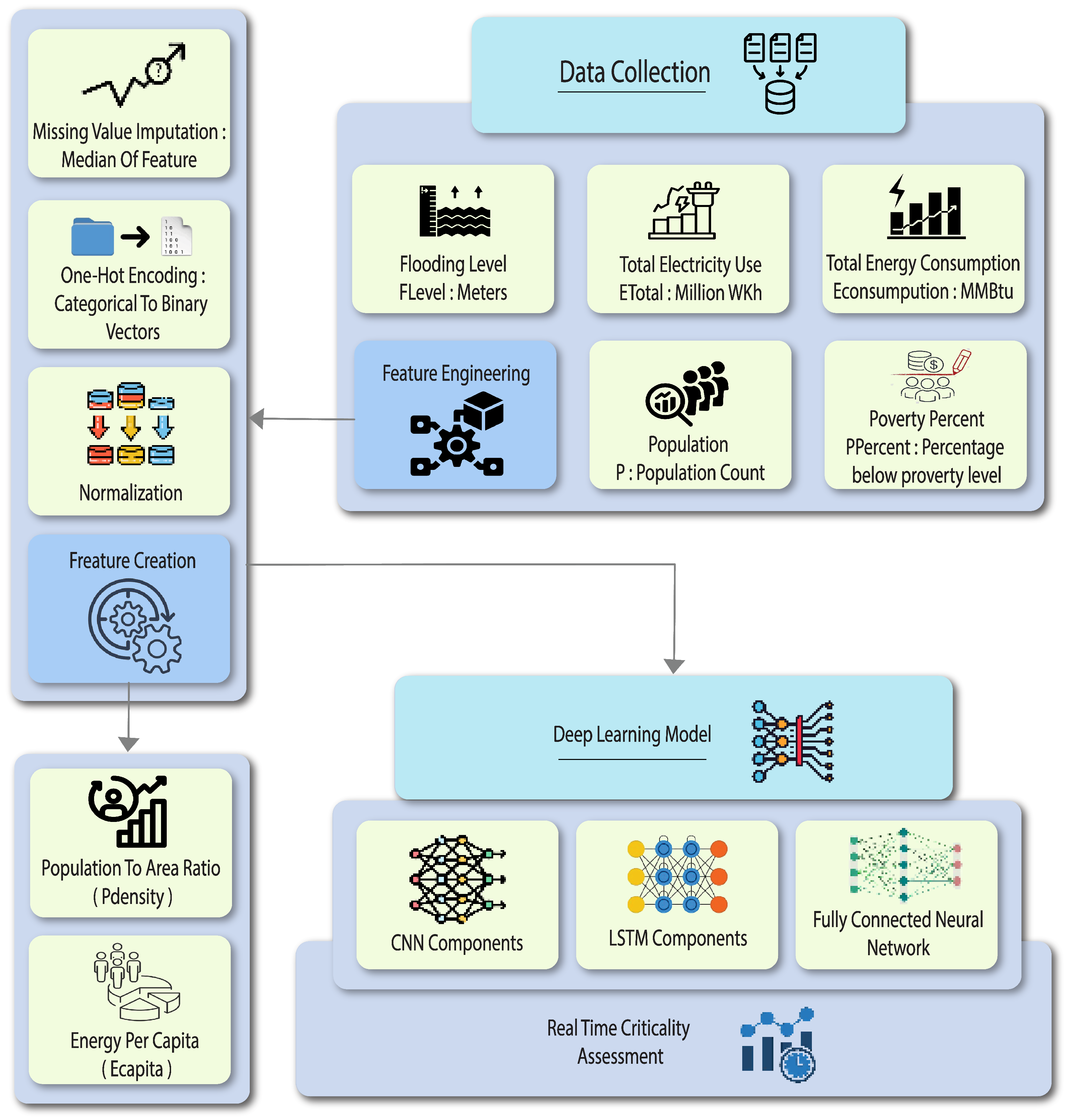
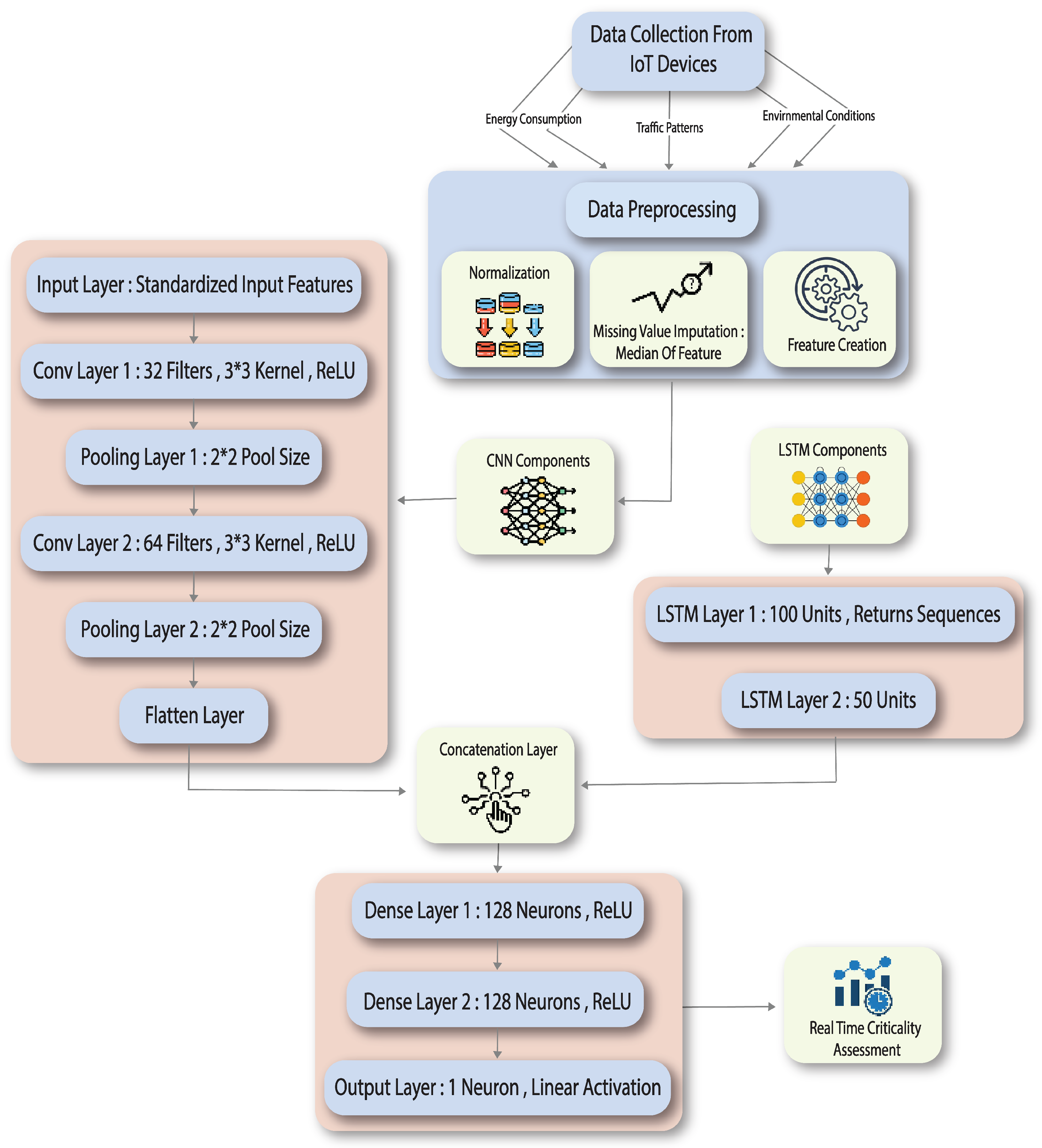
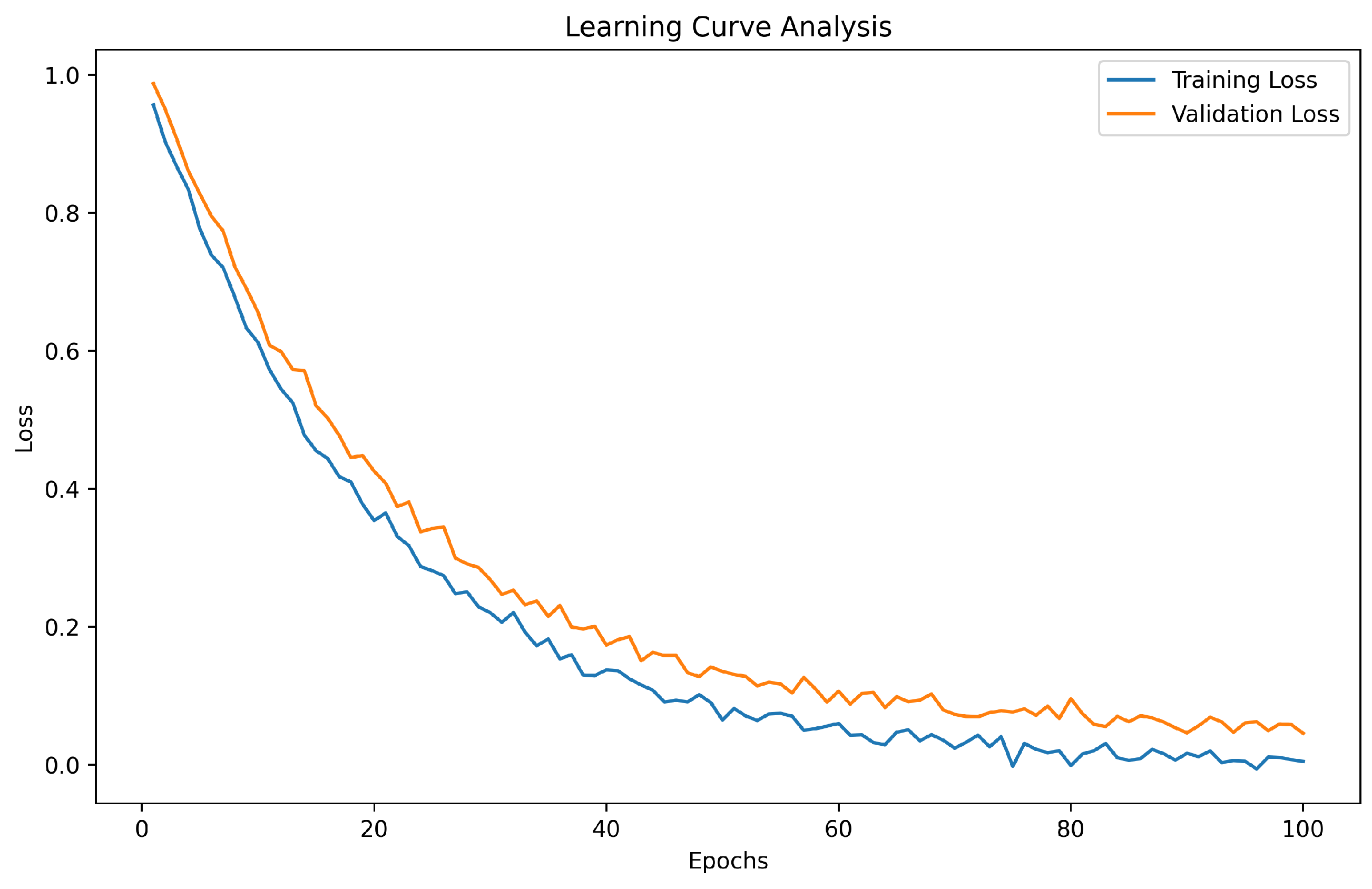


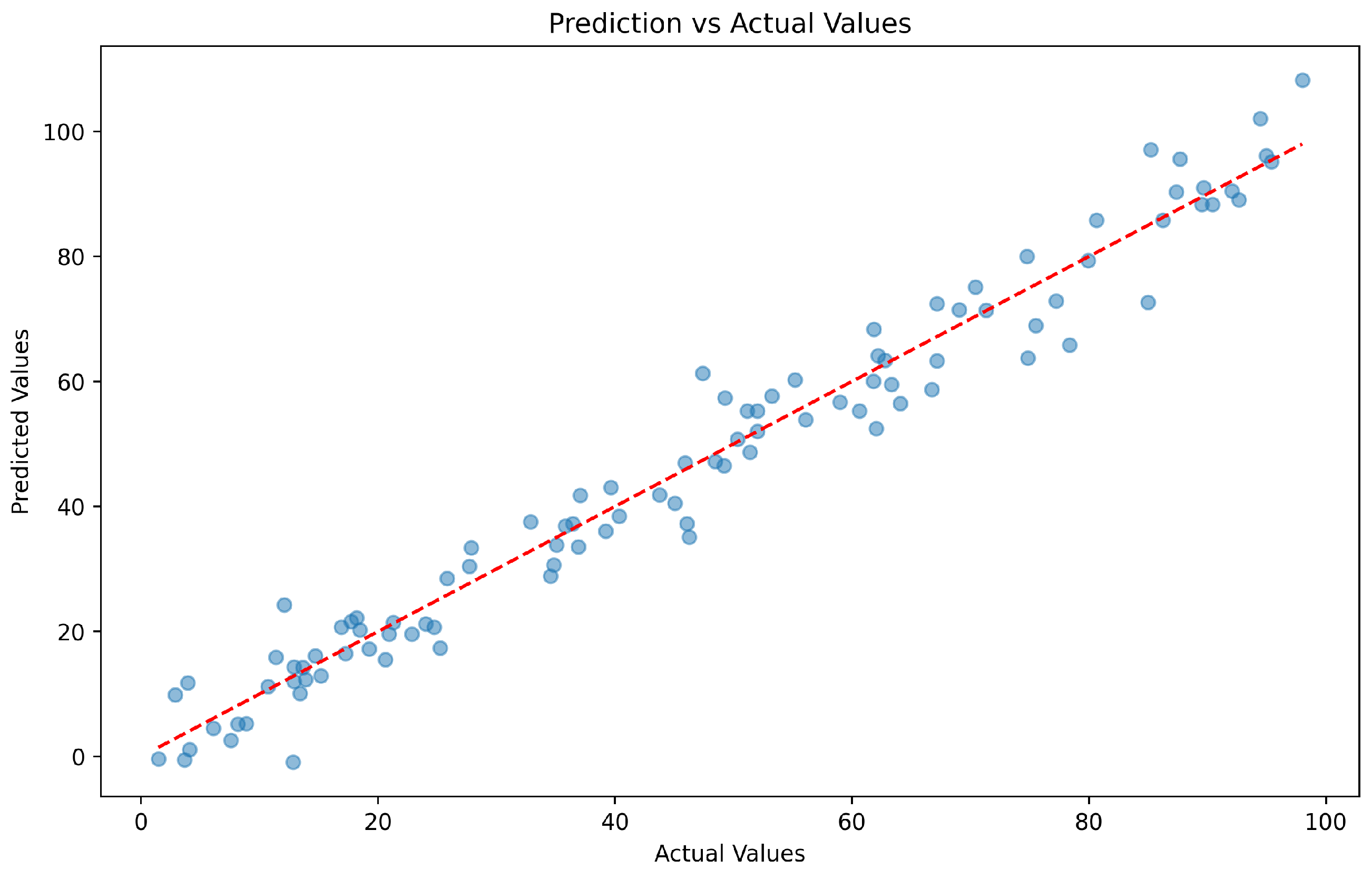
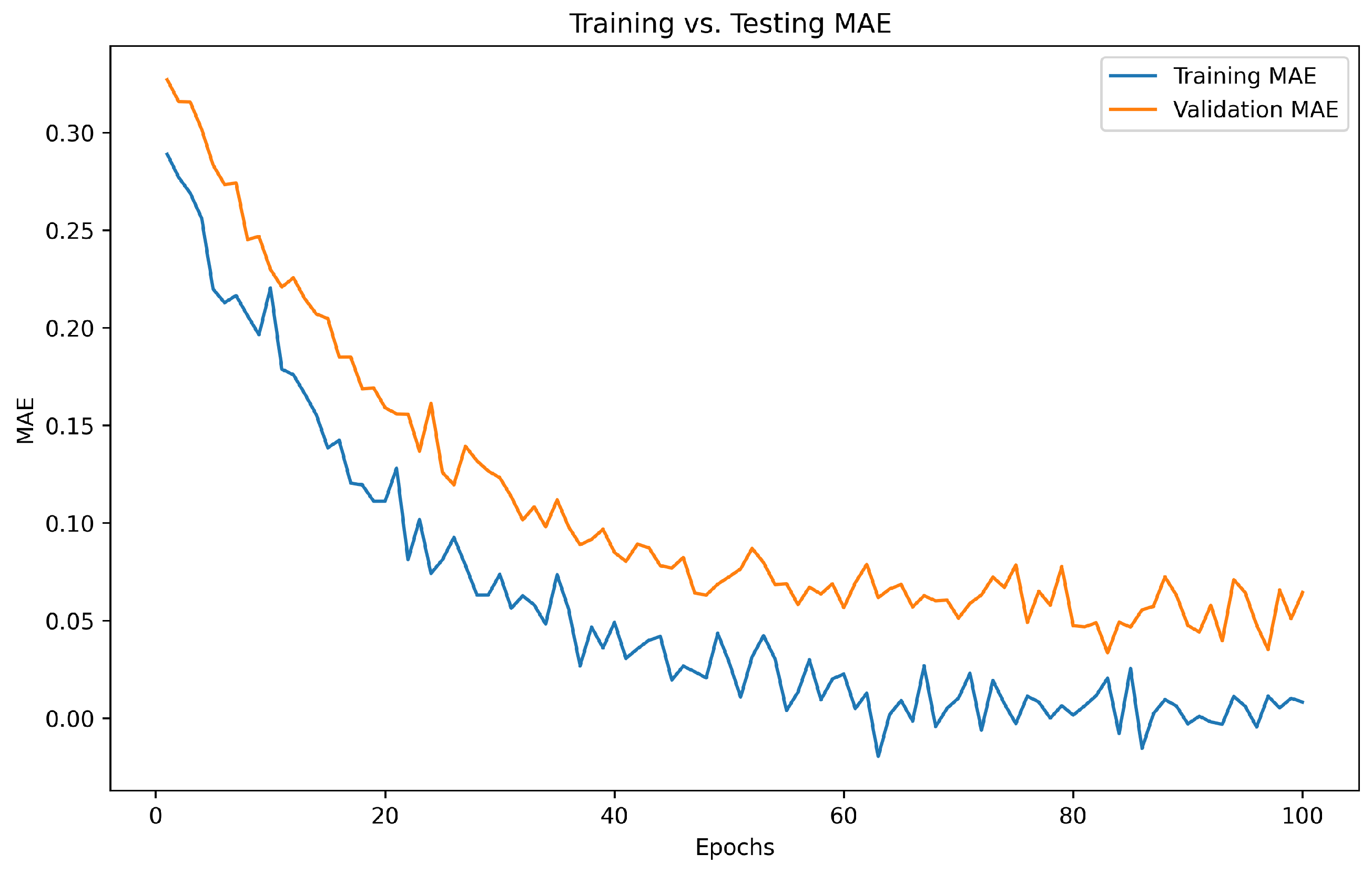
| Study | Limitations | Proposed Approach |
|---|---|---|
| [35] | Lacks adaptability to rapidly changing urban environments | Dynamic data inputs with CNNs and LSTMs for real-time adaptability |
| [37] | Complex implementation for practical applications | Simplified model architecture leveraging advanced machine learning techniques |
| [47] | Scalability issues in large IoT networks | Scalable architecture with efficient computational resource management |
| [36] | Relies heavily on availability and accuracy of real-time data | Enhanced data processing with CNNs for robust feature extraction |
| [38] | Requires substantial computational resources for real-time processing | Efficient use of LSTMs for temporal dependency capture with optimized resource use |
| [42] | Challenges in maintaining high-quality data | Integrated big data analytics for improved data quality management |
Disclaimer/Publisher’s Note: The statements, opinions and data contained in all publications are solely those of the individual author(s) and contributor(s) and not of MDPI and/or the editor(s). MDPI and/or the editor(s) disclaim responsibility for any injury to people or property resulting from any ideas, methods, instructions or products referred to in the content. |
© 2024 by the author. Licensee MDPI, Basel, Switzerland. This article is an open access article distributed under the terms and conditions of the Creative Commons Attribution (CC BY) license (https://creativecommons.org/licenses/by/4.0/).
Share and Cite
Almaleh, A. A Novel Deep Learning Approach for Real-Time Critical Assessment in Smart Urban Infrastructure Systems. Electronics 2024, 13, 3286. https://doi.org/10.3390/electronics13163286
Almaleh A. A Novel Deep Learning Approach for Real-Time Critical Assessment in Smart Urban Infrastructure Systems. Electronics. 2024; 13(16):3286. https://doi.org/10.3390/electronics13163286
Chicago/Turabian StyleAlmaleh, Abdulaziz. 2024. "A Novel Deep Learning Approach for Real-Time Critical Assessment in Smart Urban Infrastructure Systems" Electronics 13, no. 16: 3286. https://doi.org/10.3390/electronics13163286
APA StyleAlmaleh, A. (2024). A Novel Deep Learning Approach for Real-Time Critical Assessment in Smart Urban Infrastructure Systems. Electronics, 13(16), 3286. https://doi.org/10.3390/electronics13163286





